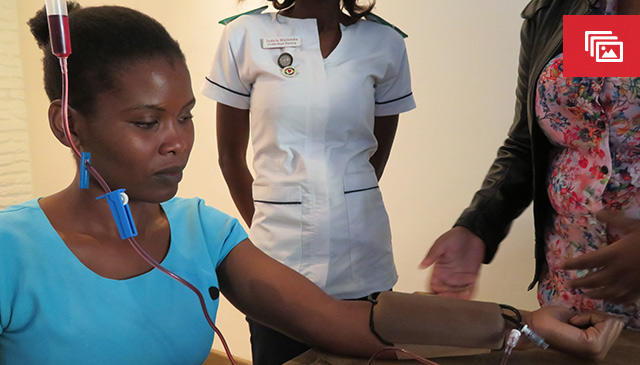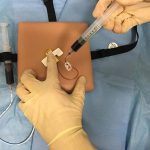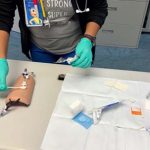
If you ask Michael Pickett, a nurse practitioner in the Pediatric Cardiovascular Anesthesia Section at Texas Children’s, what he enjoys most about his job, he’ll be quick to say – his passion for innovation and the interdisciplinary collaboration with his colleagues. Pickett says no matter how big the challenge, staying focused on the end goal is what keeps him going.
“What I like about innovation is you have to expect the unexpected,” said Pickett, who also serves as an innovation mentor for the Texas Children’s Hospital Global Hematology-Oncology Pediatric Centers of Excellence and Nursing Innovative Solutions Council (ISC) at Texas Children’s. “There’s no guarantee that you’re going to be successful. But the hope is that you will be, and you just have to keep working at it.”
When Pickett was a graduate nurse 22 years ago, he says he faced many of the same challenges new nurses encounter when inserting a peripheral intravenous (PIV), performing central venous catheter (CVC) care and maintenance, and accessing a port on a patient for the first time. Back then, he wished there were more simulation training tools available when he was a new nurse.
As a natural innovator at heart, Pickett was determined to turn this vision into reality. Sharing his concepts with frontline innovators at Texas Children’s, Pickett gained the support from nursing colleagues and leaders across the organization who provided continual feedback throughout the innovation process. It quickly became the team’s goal to develop and implement novel skills technique videos partnered with the PIV, CVC and Port Task Trainers designed by frontline innovators that are wearable, cost-effective, durable, realistic and allow all procedural steps trainees would perform. A secondary goal was to document and open-source the innovation process utilized to develop these proof-of-concepts.
After nearly four years of development including more than 20 prototype iterations and pilot surveys, two international presentations and an international SimVentor award, the RediStik Wearable PIV, CVC and Port Trainers were finalized and produced in collaboration with Sawbones®, the leader in medical models for orthopedic and medical education, along with the support from ISC, Entrepreneurship and Innovation teams, Marketing and Legal departments, and hundreds of frontline innovators representing more than 20 different clinical areas at Texas Children’s Hospital.
The Redistik Wearable PIV, CVC and Port Trainers are portable, light weight, skin models that can be placed on a live person, table top or mannequin. The trainers help clinicians master various procedural skills like how to insert a PIV line, access and de-access a port, and how to perform sterile techniques for dressing application and cap changes to prevent pressure injuries and central line associated bloodstream infections.
“When we designed the task trainers, we wanted the experience to be realistic as possible,” said Pickett, lead inventor of the Redistik Wearable PIV, CVC and Port Trainers. “With many of the current simulation task trainers on the market, once they are used a few times, you can see where to stick and it’s just not as realistic. Our task trainers have a needle proof backing to prevent accidental needle sticks and resilient material that allow for over 1,000 punctures per task trainer that can’t easily be seen on the skin model.”
The RediStik PIV, CVC and Port Trainers were piloted in 2019 and are now being used throughout the Texas Children’s system. The nurse residency program has implemented PIV insertion skills training during new nurse orientation using the Redistik PIV trainers. Prior to training, 15 percent of nurses surveyed said they were “confident” on starting PIV lines. After completing training, their confidence level rose to 96 percent.
“We used the PIV and Port Trainers during our annual training and everyone appreciated the hands-on practice,” said Kate Jones, a decentralized education coordinator. “The ability to move the port placement around to increase the difficulty of access and the ability to get blood return made it much more realistic.”
The impact of Pickett’s innovation can also be felt around the globe. The RediStik PIV, CVC and Port Trainers have been piloted at Texas Children’s Global HOPE clinics in Sub-Saharan Africa where the PIV trainer has had a significant impact on improving their rates of PIV extravasations and reducing PIV attempts.
Far reaching impact
Global HOPE Director of Nursing Education Dr. Marilyn Hockenberry said when she learned about the RediStik PIV Trainer she was ecstatic because the rate of PIV attempts was high in her clinics as well as IV extravasation, which is when you are administering a drug, such as chemotherapy, and it seeps into the outer tissues surrounding the injection site causing painful inflammation.
“Children with cancer in Africa don’t have the benefit of a central line,” Hockenberry said. “All chemotherapy is done through a peripheral vein, creating challenges for both our patients and our providers.”
The use of the RediStik PIV Trainer has greatly reduced these challenges, lessening both the number of PIV attempts and IV extravasation incidents. Hockenberry introduced the innovation to her clinics in Botswana, Malawi and Uganda more than a year ago holding regular hands-on training workshops, many of which are still being held today.
During the workshops, clinical staff learn how to put in a peripheral intravenous line, care for the line and confidently administer chemotherapy. Prior to the trainer, staff learned as they cared for patients. There was no way to do hands-on training.
Competencies learned on the PIV trainers have decreased extravasation rates from 42 percent to 5 percent in less than a year’s time. Prior to using the task trainer, only 19 percent of PIVs were obtained with three or fewer attempts compared to 99 percent after the post task trainer assessments.
“If you want to cure cancer in Africa you have to improve IV use, PIV use and the administration of medication,” Hockenberry said. “These devices are great for making that happen.”
Hockenberry added that without people like Pickett and the team of innovators, the progress made in Africa would not have been able to happen. She said Pickett and the innovation team are crucial to the clinical process and have made a significant difference in the lives of our patients around the globe.
“It’s just a great feeling to see how these innovative training tools have benefited our staff and our patients,” Pickett said. “It took a lot of hard work to finally get to this point, but it was all worth it.”
About Redistik
Visit www.texaschildrens.org/redistik to access product details, skills video tips/techniques and data outcomes. Click here to learn more about Sawbones®.
Contact Michael Pickett at mtpicket@texaschildrens.org if you would like to check out one of the RediStik products for staff training.















